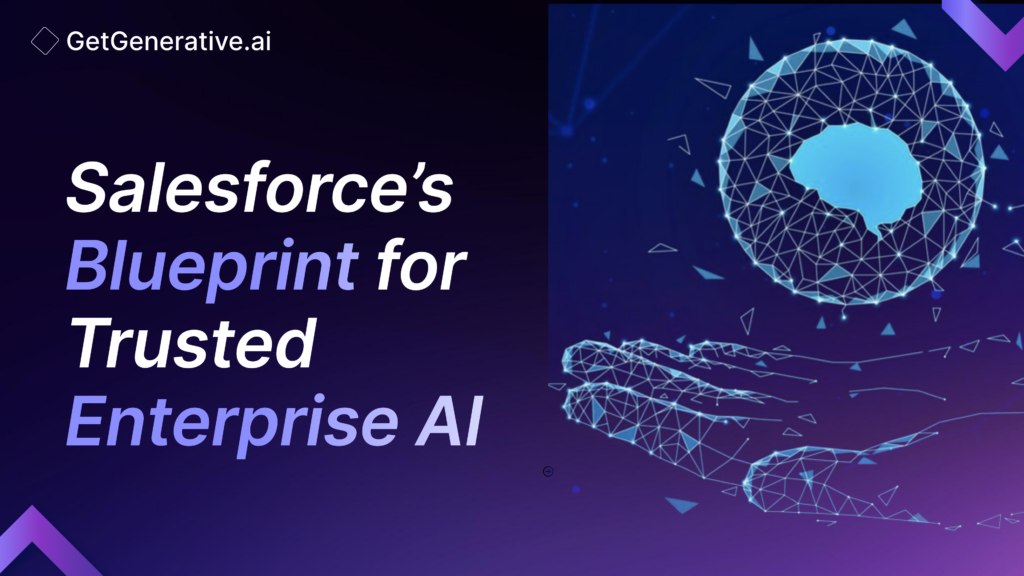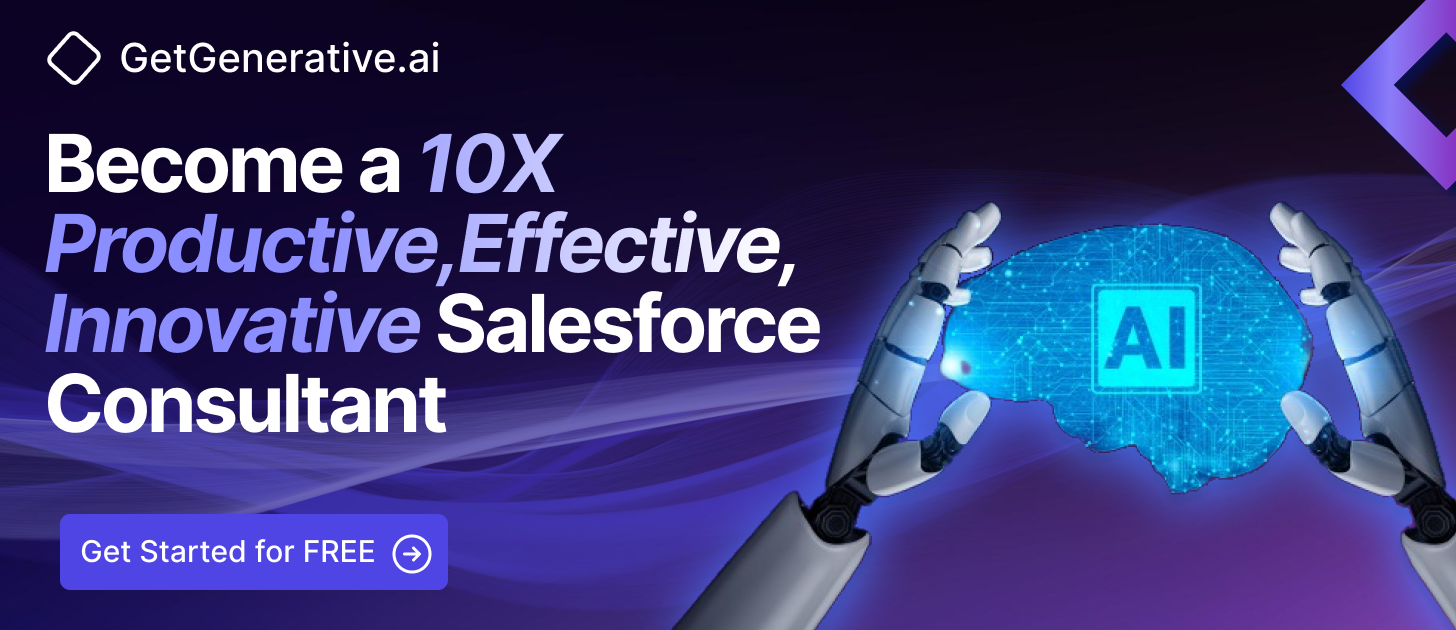Salesforce’s Blueprint for Trusted Enterprise AI
Trust and transparency have become paramount in the dynamic artificial intelligence (AI) world. As AI technology evolves, organizations face increasing scrutiny regarding AI systems’ ethical implications and governance. Salesforce, a leader in enterprise solutions, has taken a significant step forward by updating its AI policy framework in a whitepaper. This framework ensures that AI development and deployment are conducted responsibly, ethically, and transparently.
Why an Enterprise AI Policy Framework?
Enterprise AI operates within the complex business operations landscape, handling sensitive customer data, automating critical processes, and influencing decision-making across various functions. Considering the significant implications, a strong AI policy framework is crucial for multiple reasons:
- Reducing Risks: AI systems might inadvertently reinforce biases, make incorrect choices, or be used for harm. A detailed policy framework assists in recognizing and reducing these risks, promoting ethical and responsible use of AI.
- Establishing Trust: Customers, employees, and stakeholders must know that AI systems are equitable, transparent, and secure. An explicit policy framework shows an organization’s dedication to responsible AI operations, enhancing trust and reliability.
- Ensuring Compliance: A policy framework helps organizations comply with legal and ethical standards as AI regulations evolve.
- Promoting Innovation: Clear policy guidelines provide developers with the guardrails needed to explore AI’s potential while adhering to ethical principles.
The Initial Framework by the World Economic Forum
The World Economic Forum’s Initial Framework, established by the AI Governance Alliance (AIGA), serves as a fundamental method for creating global norms for the ethical development and implementation of artificial intelligence. Introduced in June 2023, AIGA is a trailblazing initiative involving multiple stakeholders from diverse sectors such as industry, government, academia, and civil society. This framework plays a critical role in tackling AI’s intricate issues and prospects, promoting a harmonious advancement of technology underpinned by ethical governance.
Core Workstreams of the First-Generation Framework
AIGA’s framework is built around three principal workstreams, each designed to cater to different aspects of AI governance:
1. Resilient Governance and Regulation:
- Objective: This workstream aims to anticipate future governance needs and develop durable institutions for AI oversight. It focuses on creating flexible yet robust regulatory environments that can adapt as AI technologies evolve.
- Strategies: Implementing forward-looking regulatory measures, promoting global cooperation among regulatory bodies, and ensuring that AI governance frameworks can withstand technological and societal changes.
2. Safe Systems and Technologies:
- Objective: This workstream addresses the technical and ethical challenges in AI implementation to ensure the development of secure, reliable, and ethically sound AI systems.
- Strategies: Develop standards and guidelines for the ethical design of AI systems, advocate for incorporating safety and security features from the inception of AI development, and promote transparency in AI operations.
3. Inclusive Progress:
- Objective: This workstream promotes equitable access to AI’s benefits and addresses the digital divide. It seeks to ensure that AI advancements contribute positively to all segments of society.
- Strategies: Encourage the development of AI applications that address societal needs, promote digital literacy and AI education for various demographics, and ensure that AI deployment considers socio-economic disparities.
Publications and Reports
AIGA consistently releases reports and guidelines that concentrate on developing secure systems and technologies, strongly focusing on ethical aspects across the AI value chain. These documents are essential tools for policymakers, developers, and other participants in the AI community. They offer insights into optimal practices for AI safety, ethical issues, and fostering inclusive technological advancement.
Collaborative Approach
The collaborative nature of AIGA underscores the belief that responsible AI development is a collective endeavor. By bringing together diverse perspectives, the alliance fosters a more comprehensive understanding of AI’s impact. It ensures that various stakeholders have a voice in shaping AI policies. This inclusive approach is crucial for building global consensus on AI standards and practices, enabling tackling shared challenges and harnessing AI’s potential responsibly.
The World Economic Forum’s First-Generation Framework through AIGA sets a significant precedent for global AI governance, emphasizing resilience, safety, inclusivity, and collaboration. As AI continues to permeate various facets of society, this framework provides a solid foundation for navigating the ethical landscape of AI technology.
Salesforce’s Second-Generation Framework
Salesforce’s Second-Generation Framework, detailed in the whitepaper “Shaping the Future: A Policy Framework for Trusted Enterprise AI,” builds on the foundational principles of the World Economic Forum’s AI Governance Alliance. This framework is designed to meet the nuanced demands of business operations using AI technologies, emphasizing practicality and actionability tailored to enterprise needs.
Key Components of Salesforce’s Second-Generation Framework
The framework is structured around several key components that address the specific challenges and opportunities presented by enterprise AI:
1. Clear Definitions:
- Purpose: To eliminate ambiguities by clearly defining the roles and responsibilities of various actors within the AI value chain, including developers, deployers, and distributors.
- Impact: By specifying roles, Salesforce ensures that each participant in the AI ecosystem understands their responsibilities, which is crucial for maintaining accountability and integrity in AI applications.
2. Risk-Based Approach:
- Purpose: To prioritize regulatory and oversight efforts on high-risk AI applications that could have significant negative impacts if mismanaged.
- Impact: This approach allows for flexibility and encourages innovation in lower-risk scenarios, ensuring that safeguards are stringent for critical applications with greater potential for harm.
3. Transparency and Explainability:
- Purpose: To go beyond general calls for transparency, we will implement specific requirements for documentation, human oversight, notifications to individuals, and explicit disclosures during interactions with AI systems.
- Impact: Enhancing user understanding of how AI systems work and how personal data is utilized, fostering trust and making AI systems more user-friendly and approachable.
4. Data Governance:
- Purpose: To ensure that AI systems are built and operate on high-quality, representative data while protecting sensitive information.
- Impact: Salesforce emphasizes data minimization, storage limitations, and clear data provenance practices, which protect user data and ensure the integrity and effectiveness of AI operations.
5. Globally Interoperable Frameworks:
- Purpose: To advocate for consistent and interoperable AI policy frameworks across international borders, particularly relevant for multinational corporations.
- Impact: This global approach facilitates smoother operations across different regulatory landscapes and promotes a unified standard for enterprise AI, ensuring that Salesforce’s solutions are globally viable and ethical.
Strategic Implementation
Salesforce’s framework addresses theoretical aspects of AI governance and focuses on practical implementation. For instance, Salesforce has developed tools and protocols to ensure that the framework’s principles are applied effectively within its operations and product offerings. This includes:
- Training Programs: Implementing comprehensive training for developers and operators to ensure they are familiar with ethical AI practices and understand the framework’s guidelines.
- Audit and Compliance Mechanisms: Establish regular audits and reviews to ensure ongoing compliance with the framework, adjusting practices to align with evolving AI technologies and regulatory requirements.
- Stakeholder Engagement: Engaging with customers, regulators, and other stakeholders to gather feedback and continuously refine the framework.
The Einstein Trust Layer: A Calculated Risk
Salesforce’s introduction of the Einstein Trust Layer represents a strategic and forward-thinking component of its AI policy framework. This initiative aims to establish Salesforce as a leader in secure and trustworthy AI within the enterprise sector. By implementing the Einstein Trust Layer, Salesforce addresses growing concerns around AI risks and aligns its technology with the core company value of trust.
Purpose and Strategy of the Einstein Trust Layer
1. Branding Trust and Safety:
- Purpose: To position Salesforce as a proactive AI trust and safety leader.
- Strategy: By branding the trust and safety features early in the development of AI solutions, Salesforce aims to capitalize on the market’s growing demand for secure and reliable AI technologies.
2. Integration with Core Services:
- Purpose: Weave trust and safety into the fabric of Salesforce’s existing and future AI offerings.
- Strategy: The Einstein Trust Layer is integrated into various Salesforce products, ensuring that the company’s AI solutions adhere to the highest standards of data security and ethical AI practices.
Challenges and Risks
The Einstein Trust Layer, while strategic, involves significant risks and challenges that Salesforce must navigate:
Real-World Application:
- Challenge: Implementing the Trust Layer effectively across various AI products, including complex systems like the Einstein Copilot for Shoppers.
- Risk: Unexpected technical and operational challenges could undermine the effectiveness of the Trust Layer if not managed properly.
Maintaining Transparency and Accountability:
- Challenge: To maintain high transparency regarding how the Trust Layer functions and manages data.
- Risk: Any failure to provide clear and accurate disclosures may erode trust among users and stakeholders.
Scaling Trust Features:
- Challenge: Ensuring the Trust Layer can be scaled effectively as Salesforce expands its AI offerings.
- Risk: If scalability issues arise, it could limit the deployment of the Trust Layer across all intended products and services, impacting overall trustworthiness.
The Einstein Copilot for Shoppers: A Test Case
The Einstein Copilot for Shoppers, a chatbot designed to enhance customer interactions while safeguarding data, serves as a critical test case for the Einstein Trust Layer:
- Functionality: The Copilot is designed to interact seamlessly with customers, providing personalized shopping experiences based on AI-driven insights.
- Security Features: It incorporates advanced security measures to protect sensitive customer information and ensure that interactions are private and secure.
Potential for Reputational Impact
Salesforce is acutely aware of the reputational risks involved with deploying AI solutions like the Einstein Trust Layer:
- The “Air Canada Moment”: Refers to a cautionary tale where Air Canada faced legal and financial repercussions due to the failures of its AI-driven systems. Salesforce uses this example to highlight the importance of delivering on its promises regarding AI capabilities.
- Building Public Confidence: By successfully implementing the Einstein Trust Layer, Salesforce aims to strengthen its market position and build public equity in trusted AI.
Salesforce’s Einstein Trust Layer is a calculated risk that could significantly advance the company’s reputation and leadership in trusted enterprise AI. The success of this initiative hinges on its effective real-world application, scalability, and ability to maintain trust and transparency with users. By navigating these challenges, Salesforce can set a new industry standard for secure and ethical AI solutions, ultimately fulfilling the promise of AI that is not only powerful but also profoundly trustworthy.
The Extended Journey Forward
Salesforce’s revised policy framework signifies important advancements, yet the path toward reliable enterprise AI remains extensive. It is essential to continually adjust and refine strategies and practices to align with the swift advancements in AI technology. Salesforce stresses the importance of persistent stakeholder collaboration to tackle emerging challenges and possibilities.
AI technologies will inevitably raise new ethical issues and regulatory concerns as they progress. Salesforce’s dedication to developing AI systems that are trusted, transparent, and accountable equips them effectively for this changing environment. Demonstrating real benefits while adhering to ethical standards will be vital as more businesses integrate AI technologies.
Also, Read – Salesforce Introduces Einstein Copilot Everywhere
Conclusion
The policy framework Salesforce has introduced for trusted enterprise AI adds significant value to discussions on responsible AI implementation and management. By addressing specific business needs, focusing on transparency and data management, and offering actionable insights, Salesforce sets the stage for a future where AI is influential and dependable. Although the journey is lengthy, the vision of trusted enterprise AI can be achieved through ongoing cooperation and a solid commitment to ethical values.
Visit getgenerative.ai to learn more!
Frequently Asked Questions (FAQs)
1. What is Salesforce’s AI policy framework?
Salesforce’s AI policy framework is a set of guidelines and principles designed to ensure the responsible, ethical, and transparent development and deployment of AI within enterprise environments.
2. Why did Salesforce update its AI policy framework?
Salesforce updated its AI policy framework to address evolving regulatory, ethical, and operational challenges in AI, aiming to enhance trust and safety in its AI solutions.
3. What is the Einstein Trust Layer?
Salesforce’s strategic initiative to embed trust and safety features into its AI products ensures that these technologies are secure and operate in accordance with ethical standards.
4. How does Salesforce’s framework address AI risks?
The framework advocates a risk-based approach, focusing regulatory efforts on high-risk AI applications while promoting flexibility and innovation in lower-risk areas.
5. What makes Salesforce’s framework unique compared to others?
Salesforce’s framework is unique in its clear definitions of roles within the AI value chain, its emphasis on transparency and data governance, and its advocacy for globally interoperable AI policy frameworks.




